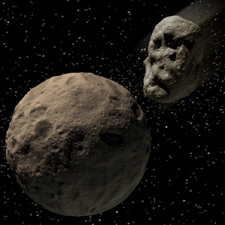
When asteroids collide at speeds of a few kilometers per second, the kinetic energy creates a fireball and large amounts of dust. In the case of the Veritas collision, that dust found its way back to Earth.
NASA / JPL / Caltech / T. Pyle (Spitzer Science Center).
The asteroid belt teems with perhaps a million bodies at least 1 kilometer (0.6 mile) across, so every so often two of them are bound to run into one another. According to David Nesvorny (Southwest Research Institute, Colorado), a particularly powerful smashup took place about 8.3 million years ago. That event turned a 140-km-wide target body into a "family" of asteroidal fragments with similar orbits, the largest being 490 Veritas (115 km in diameter). It also created an enormous cloud of interplanetary dust, the pulverized equivalent of a rocky body 10 to 15 km across.
Although the Veritas collision occurred 500 million km (300 million miles) from the Sun, drag induced by sunlight and the solar wind would have quickly caused the smallest dust particles to spiral inward, bathing Earth with a weak “dust shower” lasting roughly a million years. Writing about the event in 2003, Nesvorny and three coauthors urged geologists to look in ancient sediments for traces of interplanetary dust enriched in the solar-wind isotope helium-3 (3He).
A team led by Kevin A. Farley (Caltech) took up the challenge, and in the January 19th issue of Nature, the researchers announce finding sediment layers in two deep-sea drill cores with four times the normal abundance of 3He. Both layers have the same age – 8.2 million years – thus making a convincing link to the asteroidal breakup.
“The helium-3 spike found in these sediments is the smoking gun,” Farley says. Asteroid-belt collisions involving such a large object are rare, adds team member Nesvorny, and the breakup of Veritas’s precursor ranks as the largest smashup in the last 100 million years.
The deep-sea cores also contained a somewhat weaker 3He spike corresponding to about 35 million years ago, an enhancement that Farley and others first identified in 1998. But that age doesn’t corresond to any known impact event either in the asteroid belt or here on Earth. Conversely, no enhancement was found in layers that formed just 5.8 millions ago. That, Nesvorny calculates, is when a pair of asteroids 6 and 33 km across shattered one another to form a 90-member family that includes 832 Karin.
 0
0
Comments
You must be logged in to post a comment.